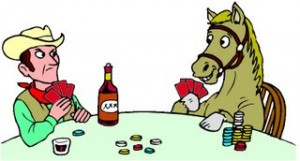
Sistine extends her upper lip to touch her jolly ball during a session. This is a confirmation of relaxation and engagement.
Most trainers are deeply familiar with their chosen species’ body language. It’s a basic requirement for making training decisions and something that we take for granted as part and parcel of our work. Many trainers use body language as a guide in their teaching progression, automatically, without even having to think about it. But being able to be conscious of what specific signals are guiding our work allows us to be even more deliberate and clean in our training choices.
 I like to think of certain expressions of body language is as “tells”, a term I borrowed from poker. In cards, hiding your emotions is a strength, so you can bluff without your opponents guessing at your hand. In reality, though, it’s really difficult to suppress expression, and it’s common for other players to learn what you look like when you know you are about to win and what you look like when you know you are going to lose. Emotions want expression and often our body language speaks regardless of our conscious intent. These consistent expressions are known as tells.
I like to think of certain expressions of body language is as “tells”, a term I borrowed from poker. In cards, hiding your emotions is a strength, so you can bluff without your opponents guessing at your hand. In reality, though, it’s really difficult to suppress expression, and it’s common for other players to learn what you look like when you know you are about to win and what you look like when you know you are going to lose. Emotions want expression and often our body language speaks regardless of our conscious intent. These consistent expressions are known as tells.
In horse training, being able to read your horse’s tells allows you to support them within the context of a training session. It lets you know whether they feel like they have a good hand or a bad hand at the moment in the training session, so you can adjust accordingly. In order to learn your horse’s tells, it’s helpful to video training sessions so you can go back and observe as many times as you need to. Let’s have a look at Sistine at her stationary target while being brushed:
When Sistine is comfortable and in seeking mode, not only does she continue chewing her grain and remain very mobile in her neck, but she is almost continuously active with her upper lip. When she is actively using her lip to move and manipulate the jolly ball, this is a tell for me that whatever activity I am working on : brushing, fly spray, etc is not or no longer a stressor for her.
Now let’s look at a decidedly different scenario:
In the above video, you will see me introducing a brand new spray to Sistine. She is actually quite comfortable with fly spray, but this is a skin spray and it has a really different scent from the fly spray. You will see her lips start to wiggle, or wiggle a little at first when she initiates touch on the ball, but then as I begin spraying her lips stop moving, she stops chewing and becomes generally very still. This is a classic freeze response and it means the horse is moving toward discomfort and into survival mode. Horse people miss and misinterpret freeze responses frequently as compliance, and it’s the reason many mustangs have a reputation for exploding “out of nowhere”. Freeze tends to be low on the ladder of conflict responses, so it is often what precedes a much larger flight or fight response. In addition, when we have taught our horses to “do nothing” or just stand still, it can be really hard to see the freeze response. But we need it! It’s predictive. So, in this case, the entire freeze response is her tell that she needs the spray split down into more manageable approximations.
Learning to be conscious of our individual learner’s tells is good homework for the human trainer and a way to keep our training learner-centric for the horse. All the stories people tell about their horses, “He exploded out of nowhere!” or “She was fine yesterday but today she is acting like she’s never been sprayed before!” are usually stories about failures of observation. Being a trainer is a journey of learning how to see. Its valuable to notice that Sistine stayed on her target without moving her feet, even while being sprayed with the new, unpleasant (to her) spray. If I wasn’t observant of smaller, more nuanced signals from her, I might believe she was “just fine” with being sprayed because she stayed still, near the ball. But I know her tells for true comfort, and they weren’t present.
The beautiful thing about tells to me, is if you follow them they will never lead you into conflict. They are always true. So, go find your horse’s tells and honor them. Let your horse lead you at their pace, with their nervous system, into the space they can inhabit without any concern. Then you will know how to see a horse.
